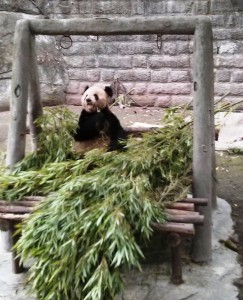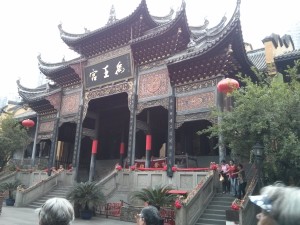There are pics this week. I was very surprised to learn that internet access is included in our cruise package. As is happy hour with wine and cookies. I think I might enjoy the wine and cookies more. ;-) They warned that there will be times when the internet doesn’t work because the boat is not able to see the satellite.
We started our day with a flight to Chongqing. got its 15 minutes of modern fame when Chang Kai Check moved his government here during the Chinese-Japanese war (which we call WW II). It is best known in the US by the Flying Tigers, which was a US team sent to help China establish a realistic air force. I learned that the name “Flying Tigers” was established through a misunderstanding. When Claire Lee Chennault founded the Flying Tigers, he brought P-40 aircraft, which had shark mouths painted on the nose. The Chinese in Chongqing didn’t know what a shark was, but they thought the nose art made a fine looking tiger.
We first toured the zoo, where we saw Panda Bears, Red Panda Bears, Asian Tigers, and White Bengal tigers. That’s quite a bit for a 1-hour zoo visit. After that, we went to China’s Chinatown. This rather confusing concept was caused by a war between the Chinese and *somebody* 300 years ago. The Chinese lost the war. The *somebodies* became the rulers. And the *somebodies* decided the Chinese should build a nice area for them in Chongqing. The Chinese used one of the buildings they built to stage their operas, socialize, help the poor Chinese with rice and money, etc. I don’t know that the place has an official name, but was told we could call it Hu Gong.
Our dinner was quite good. It’s the first time we had what we in the US would consider typical Chinese food. Then it was time to board the boat. We have the opportunity of taking a lot of optional tours (that cost extra money). But Danita and I plan to stick with the three tours included in our program.
Here are some observations about Tibet. Chinese police presence is very strong in Tibet. One occasionally sees heavily armed police, but they are not threatening. The Chinese way is to try to talk an errant person into correcting his misbehavior. If he does, no formal charges are filed. If he doesn’t the police will eventually step in. It’s all part of the game of keeping a large country in line where it’s important to avoid losing face if possible. But there are also a lot more regular police (which are often unarmed). Our guide twice told us that we need to be more careful because undercover police speak English and can hear what we say.
Chinese are building infrastructure, opening factories, and generally moving Tibet very quickly into a modern society. To make this happen, Chinese are moving into Tibet in large numbers. A large number of Tibetans look at the modern and Americanized culture China has to offer, and are thinking that this isn’t progress. They prefer the old ways. They don’t want the modern residential high rises, the emphasis on education, the traffic, the cash economy, etc. When asked, one of our lecturers said that alcoholism has become a large issue in Tibet, as a large number of people are left behind. The Tibetans I was able to talk with hope that these issues can be resolved peacefully.




